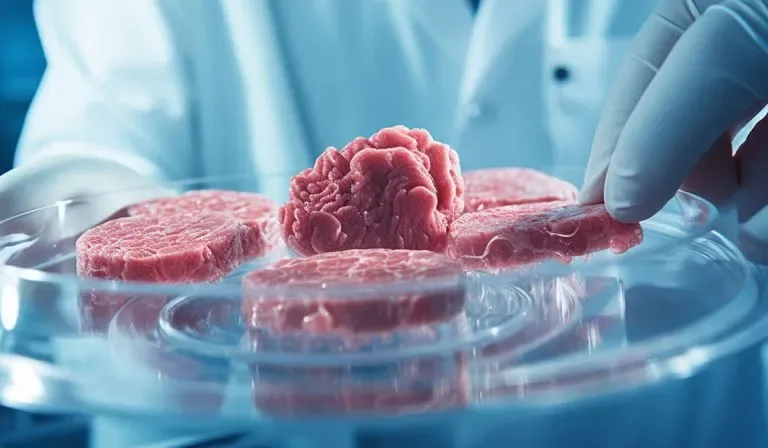U.S. regulators have approved the sale of chicken made from animal cells for the first time in what could be a landmark development for a long list of companies looking to produce lab-grown meat. The Agriculture Department gave the green light to two California firms, Upside Foods and Good Meat, to sell what is referred to as “cell-cultivated” or “cultured” meat and poultry. The approval came months after the FDA determined the products were safe to eat, and will see the USDA inspect lab-grown facilities just as it does slaughterhouses and processing plants.
Under the microscope: The move could launch a new era of meat production that could compete with the #plantbased theater. Cultivated meat is typically grown in steel tanks known as bioreactors, using cells that come from a living animal, a fertilized egg or a special bank of stored cells. In terms of production, Upside takes large sheets of the cells, forming them into shapes like chicken cutlets and sausages. Good Meat, which produces items like nuggets and satays, already sells cultivated meat in Singapore, which was the first country to approve it in 2020.
Advocates say lab-grown meat is much less likely to be infected by E. coli bacteria and other contaminants that might be found in processing facilities, while there could also be reduced exposure to antibiotics by taking farm animals out of the equation. Harm to them and the environment is also cited as an advantage, though some say cultivated meat could require even more energy and emit more greenhouse gases.
Executives at Upside and Good Meat have been quick to note that their products are meat, not substitutes like the Impossible Burger (IMPF) or offerings from Beyond Meat (BYND), which are made from plant proteins and other ingredients. However, consumer polling indicates there are initial concerns about the concept, as well as the high costs associated with mass-producing lab-grown meat. The new products will only be available in exclusive restaurants during the initial rollout phase, while industry analysts estimate it will take seven to ten years before lab-grown meat will be seen broadly in grocery stores.
US Economy
The U. Michigan consumer sentiment index showed some improvement this month, topping forecasts.

- Positive momentum in the stock market and reduced pessimism surrounding the housing market were a tailwind for sentiment this month.
- However, consumers are growing more unsettled with their present financial circumstances in comparison to their situation five years ago.

- The U. Michigan one-year inflation expectations index declined sharply this month. Longer-term inflation expectations remain elevated.

- The decrease in inflation expectations can be attributed, in part, to easing grocery prices.
- Private measures of rent inflation continue to trend lower.
- Freight spending and costs have been rolling over.

- Trucking industry prices are down sharply.

- Fed officials are preparing the market for more rate increases.

Source: @Jonnelle, @economics Read full article

- A July hike increasingly looks likely. Could we also see one in September?
- The timeline for recession expectations continues to be pushed further into the future.
- Homebuilder sentiment improved again this month as sales expectations climbed.
- However, weak mortgage applications point to downside risks, with mortgage rates hovering near 7%.
- Separately, this chart shows new home sales recoveries after housing market busts.

- Wholesale used car prices declined again.
- The May residential construction report was a shocker, with housing starts hitting a multi-year high for this time of the year.

- Building permits were also stronger than expected.
- The number of single-family homes under construction continues to fall, but multi-family units hit a record high.
- Falling construction costs have provided a significant boost to homebuilders.
- The GDPNow model has the Q2 growth hovering around 2% (annualized). Where is the recession?

- The Philly Fed’s regional services index shows companies continuing to struggle in June. The indicator of sales dropped sharply.

- Service firms are rapidly reducing staff.
- Companies are now cutting prices.
- This chart displays the proportion of imported goods originating from China.

Market Data
- The S&P 500 and Nasdaq Composite appear extended over the short term.

- Here are the RSI indicators.

- The S&P 500 has diverged from reserves (bank liquidity held at the Fed).

- The mega-cap concentration in the S&P 500 is back near the peak.

- The S&P 500 earnings yield is now well below cash yield.

- The market rally has been uneven, led by AI and large-cap tech stocks. Will breadth improve during the next stage of the bull market?

- According to Longview Economics
- The S&P500 is currently trading on an 18.8x forward P/E ratio, a level which has only been surpassed over the past 40 years during major ‘bubble-like’ events (e.g., the 2000/01 tech bubble & 2020/21 pandemic bubble, see fig 9 below). In that respect, valuation in the US remains rich and towards the top of its historical range.

- The S&P 500 valuations are bifurcated between the top 10 stocks and the rest of the index.

- The Nasdaq tends to rise into the final Fed rate hike.

- US retail sentiment is the most bullish since late-2021, shortly before the recent bear market began.

- Global M1 money supply has declined sharply.

Quote of the Week
“Be yourself; everyone else is already taken.”
~ Oscar Wilde
Picture of the Week
Stonehenge

All content is the opinion of Brian Decker






